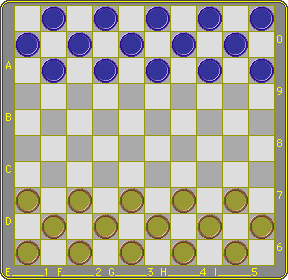Page 1 of 6
The rules mention men and kings. A king is a promoted man. If the difference doesn't matter, they may also mention pieces, for instance 'the number of pieces on the board'.
On the board there are squares and lines. These are always dark squares and oblique lines, like the 'e-line' or the '5-line'. A square is identified as the intersection of two lines. The 1- and 0-line each count but one square.
The five most distant squares from a player's point of view are called the back rank.
Initial position
 | The diagram shows the board and the pieces in the initial position. There are two players, black and white. White begins. Players move - and must move - in turn. Object
Movement Capture has precedence over a non-capturing move. If the player to move has no capture to make, he has the following options:
|
 | Piece movement
|
 | Linear movement
In actual play not all men of a line of men are moved. One simply picks up the last man of the line of men one intends to move, and puts it in front. This may be any man of the line of men from the second to the last. In the diagram all white's initial options are displayed. |
